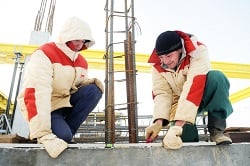
Winter weather brings freezing temperatures, salty roads and a whole mess of issues. But just because the cold hits, it doesn’t mean work has to stop. To maintain productivity on your construction site, with your employees safe and working effectively, here are some tips to help you avoid letting the elements affect your end results.
Employee Safety
It’s important to make sure your employees are safe and healthy. Start by watching the weather forecast frequently. Try to schedule jobs during the warmest part of the day, limiting time spent outdoors, keeping in mind the wind chill and any incoming storms. Also keep the schedule flexible in case of severe weather conditions.
Next, consider your employee’s individual comfort. Make sure all your workers are equipped with clothing and gear to keep them warm and dry, plus encourage them to bring along an extra set of clothes in case anything gets wet. Other safety precautions include training your team to be aware of the signs of hypothermia and frostbite and having an emergency plan. Lastly, for even happier workers, make sure you have a warm area for breaks, and/or provide heaters and warm drinks.
Material Complications
Concrete: The temperature of concrete strongly impacts how quickly it dries and hardens. So cold weather will affect concrete greatly, creating a slow drying time. It is therefore very important to protect your concrete from freezing temperatures. The concrete’s structure will be damaged if it freezes before drying.
Drywall: Spackling can be difficult if the temperature is below 60 degrees F. With spackle or joint compound, they won’t adhere to the wall properly. Paint will take longer to dry in the cold, meaning a longer time between coats. Paint can also become thick and hard to spread if it’s too chilly. To avoid these problems, make sure to bring in heaters if you can’t control the thermostat.
Protection from the Elements
De-Ice: Before work begins each day, inspect your construction site, looking at all the walkways, ladders and scaffolding. Put down salt or sand to melt ice patches, and clear ice when possible to avoid slips. Also knock off any icicles to prevent falling object hazards.
Equipment Check: You’ll also want to check and warm all the machinery and tools and ensure they’re working properly. Cold temperatures can affect the equipment, especially the electrical wires and hoses which can become brittle.
Corrosion: Any equipment, tools, and fasteners you use in exterior applications are at risk for corrosion and rust. In Winter there can be exposure to road salt as well, especially when you’re in the early stages of building construction. To protect against corrosion, consider construction products with specialized finishes like FasCoat® - a corrosion-resistant finish developed by the BECK Group, proven to withstand up to 2,000 hours and more in salt spray testing before first signs of red rust. Corrosion can be costly, so prevention is important.
With proper preparation and planning, your work and your team will be ready to face the elements!
.svg.png)

